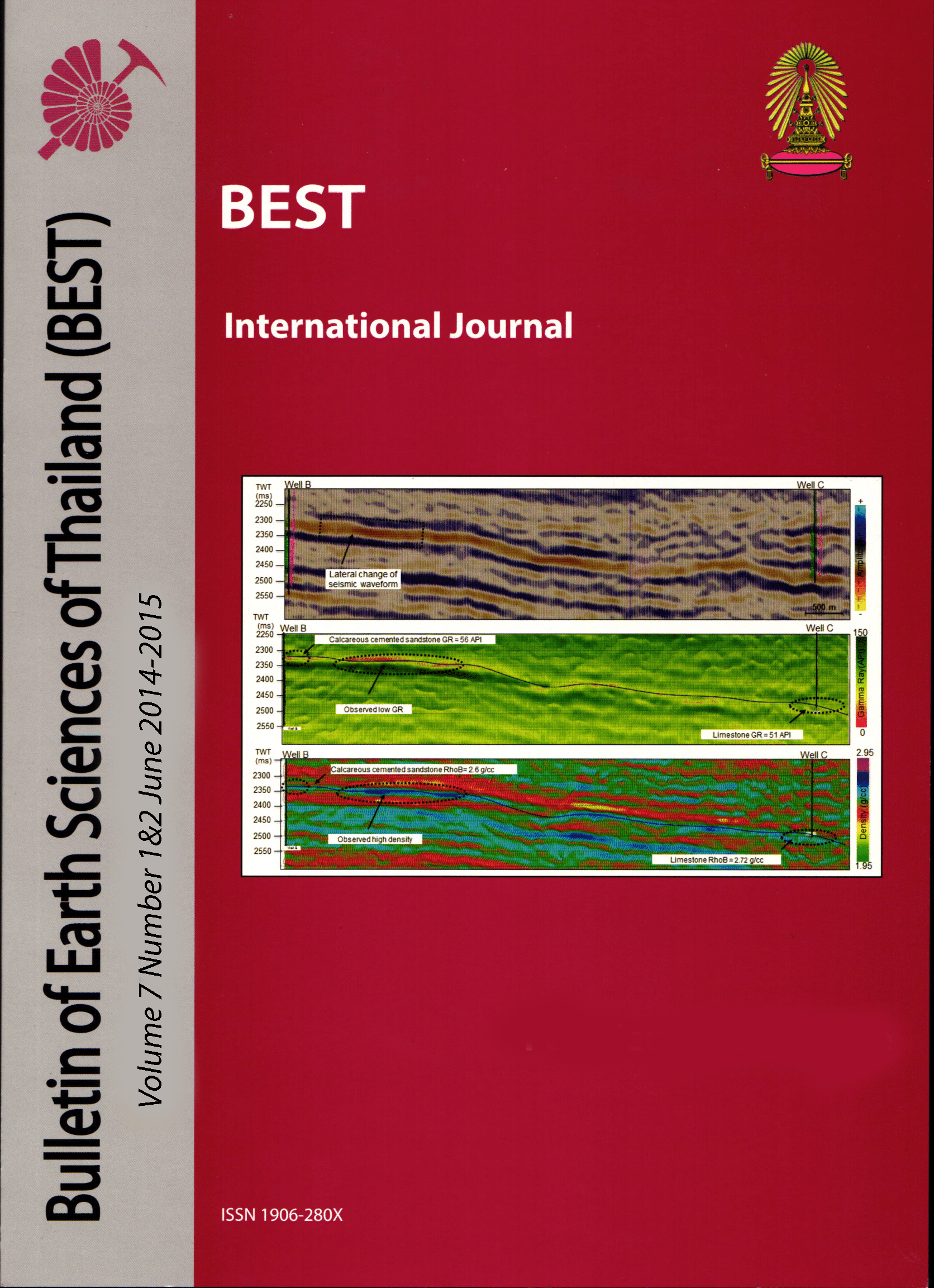Fundamental Control of Low Permeability Sandstone Reservoirs, Sirikit Oil Field Phitsanulok Basin, Thailand
Main Article Content
Abstract
Low permeability and porosity reservoirs were investigated in the Lan Krabu (L and M units) and Sarabop (P sand unit) formations. For this research, core description, poroperm relationships and well log characteristics including mineralogy were considered from available core data in north and south area, Sirikit Oil Field, Phitsanulok, Thailand. In the southern area, there are two good potential reservoirs; P sand and Lower Lan Krabu (LKU-M) units. The best reservoir quality is proximal delta front deposits (P sand unit) in a subaqueous environment. The conglomerate/coarse grained sandstone and laminated siltstone is up to 20-26% porosity and 600-1300 mD permeability. They were deposited with variable slope and energy and become progressively more distal delta front with finer grained and mud lamination. The second best reservoir quality is in distal delta front and mouthbar deposits in the LKU-M unit. It contains distal delta front silt interbedded with sand lenses and mouth bar sandstone with mud lamination and ripples. The mouthbar facies has good reservoir quality with 6-18% porosity and 0.05-40 mD permeability. The lowest reservoir quality is in the northern area reservoir facies that was deposited as crevasse splays in the Middle Lan Krabu (LKU-L) unit. This sandstone with interbedded mudstone facies has 8-11% porosity and low (0.05-0.45 mD) permeability.
Reservoir quality in the southern area is mainly controlled by depositional environment such as variable energy during deposition, clay content, sand body geometry and sedimentary structures. Conversely, the tight reservoirs in the northern area are mainly controlled by deposition and authigenic clay content. Other diagenetic processes, such as compaction, cementation and recrystallization, also degraded porosity.
Article Details

This work is licensed under a Creative Commons Attribution-NonCommercial-NoDerivatives 4.0 International License.
Copyright © 2008 Department of Geology, Faculty of Science, Chulalongkorn University. Parts of an article can be photocopied or reproduced without prior written permission from the author(s), but due acknowledgments should be stated or cited accordingly.
References
Rider, Malcolm, 1996, The Geological Interpretation of Well logs, second edition Caithness, Whittles Publishing, p. 71-77.
PTTEP, 2014, Sample preparation & routine core analysis final report, Thailand, Genlabs Petrophysical & geological services.
PTTEP, 2012, Sample preparation & routine core analysis final report, Thailand, Genlabs Petrophysical & geological services.
C & C reservoirs, 2009, Field Evaluation Report (Far East) of Sirikit Field in Phitsanulok Basin, Thailand, Miocene Lan Krabu Formation Reservoirs, p. 22 and 30.
John A., S. Adams and Charles E, Weaver, 1958, Thorium to Uranium Ratios as indicators of sedimentary processes example of concept of geochemical Facies, Bulletin of the American Association of Petroleum Geologists, Vol. 42, No. 2, p. 387-430.
Thomas F. Moslow, Evaluating Tight Gas Reservoirs, Department of Geology, University of Alberta, Edmonton, Alberta, Canada, p. 320-323.
Nichols, G and Fisher, J., 2007, Processes facies and architecture of fluvial distributary system deposits, Sedimentary Geology, 195(1-2):p. 75–90.
John A., S. Adams and Charles E, Weaver, 1958, Thorium to Uranium Ratios as indicators of sedimentary processes example of concept of geochemical Facies, Bulletin of the American Association of Petroleum Geologists, Vol. 42, No. 2, p. 387-430.
Niels N, 2014, Geological characterization of thin-bedded crevasse splay sandstones; outcrop-analogue studies for tough gas reservoir potential, Delft University of Technology, Netherlands, p 7.
R.P. Langford, J. D. Grigsby, W. E. Howard, J. D. Hall, and J. Maguregui, 1990, Sedimentary facies and petrophysical characteristics of cores from the lower Vicksburg gas reservoirs, Mcallen Ranch field, Hidalgo county, Texas, Transactions Gulf Coast Association Of Geological Societies, Vol XL, p. 439-442.
Emily F., 2013, Core Description, Lithofacies Interpretation and Sedimentological Characterization of a Mixed Provenance Alluvial Fan: the Pleistocene Tulare Formation, Midway Sunset Field, Kern County, California, Adapted from oral presentation given at Pacific Section AAPG, SEG and SEPM Joint Technical Conference, Monterey, California.
Eric E. Hiatt and Kurt Kyser, Chapter 4. Links between depositional and diagenetic processes in basin analysis: Porosity and permeability evolution in sedimentary rocks, Department of Geological Sciences and Geological Engineering, Queen’s University, Kingston, Ontario, K7L 3N6 Canada, p. 63-90.
T. A. Pollard and Paul P. Reichertz, 1952, Core-Analysis Practices-Basic Methods and New Developments, Bulletin of the American Association of Petroleum Geologists, Vol. 36, No. 2, p. 230-252.
Yu Lin, Zhangyou Xu, Shenghe Wu. 2012, Diagenetic Reservoir Facies and Diagenetic Evolutionary Sequences of Extra-Low Permeability Reservoir in the Upper Triassic Xujiahe Formation of Fenggu Structure, Western Sichuan Depression, China, Adapted from poster presentation at AAPG Annual Convention and Exhibition, Long Beach, California.


